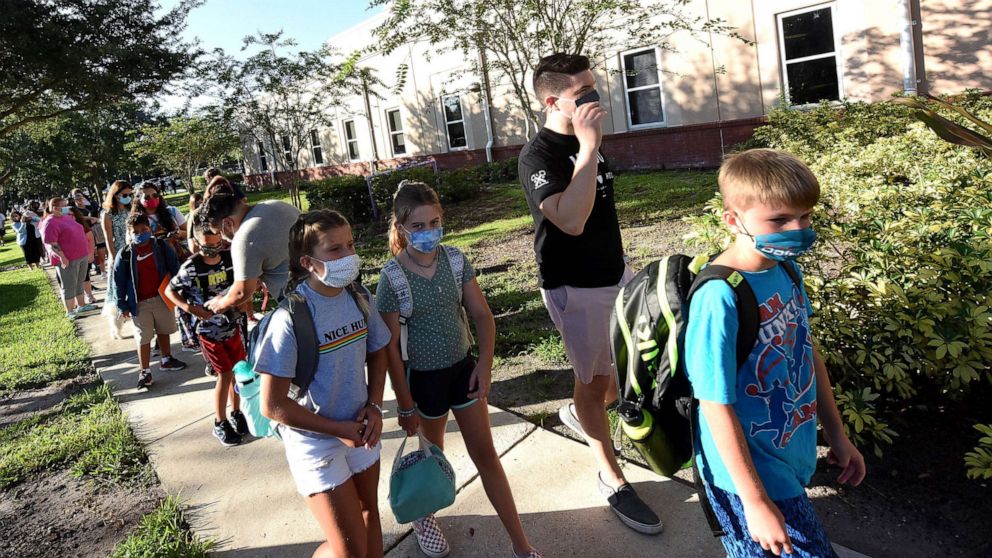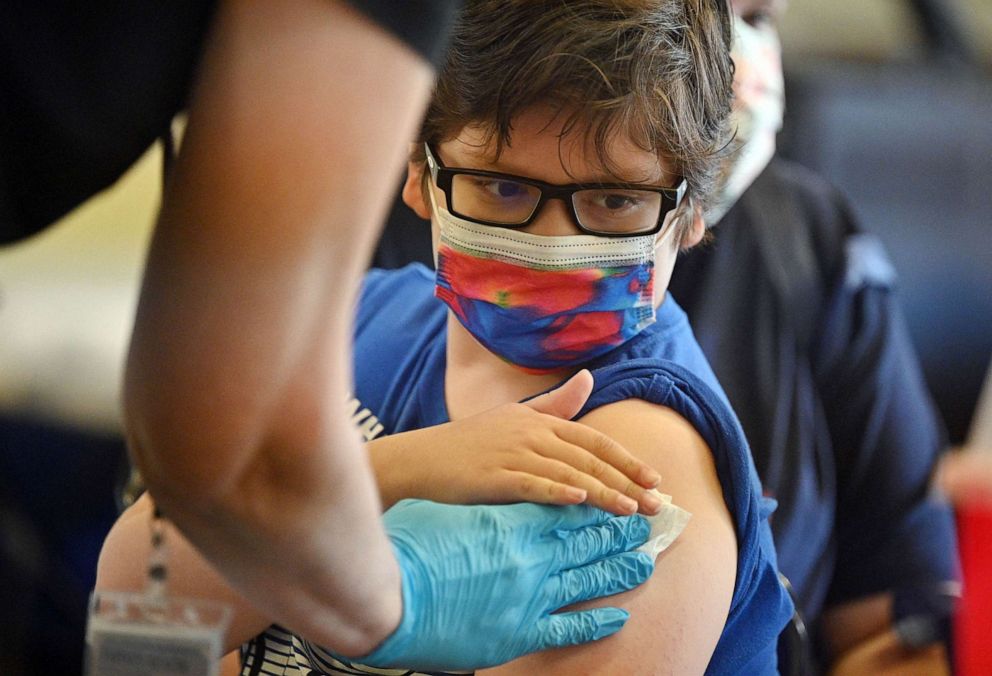In addition, COVID-19 cases and deaths rose by 50% over the past week, despite the rate previously remaining flat for a long period of time, according to the CDC.
With the ongoing surge, health officials highly recommend wearing a face mask when in crowded, indoor spaces to avoid both spreading and catching viruses.
The CDC continues to recommend mask-wearing for children and adults on public transportation, including trains, planes and buses.
“Good Morning America” spoke with Dr. Elizabeth Murray, a mom of two and a pediatric emergency medicine physician at Golisano Children’s Hospital in Rochester, New York, to answer parents’ questions about wearing face masks once again.
1. When and where should kids wear face masks?
Both children and adults should wear face masks when possible in indoor, crowded settings, according to Murray, who is also a spokesperson for the American Academy of Pediatrics.
In the absence of mask mandates, Murray said that families need to make the best decisions for themselves, knowing that each family and each individual child is unique.
“It would be so awesome and so easy if we could just kind of say, ‘You always do this,’ or, ‘You never do that,’ and it really is not at that point,” she said. “But as we head into the holidays and we want to make sure we’re healthy to see our families, now is the time to really take those precautions.”
Murray gave the example of her own family, noting that her oldest daughter, at age 13, can make decisions on her own about where and when a mask would help.
“She is able to, at her age, to kind of make decisions of, ‘I’m in a big group working close with a bunch of people, so now is a good time for me to wear a mask,’ versus, ‘I’m sitting in a study hall with three other students and we’re all spaced out so I probably don’t need to wear a mask at this point,'” said Murray. “She also is really active in a lot of extracurricular activities that are really important to her, so she is more comfortable wearing a mask during school or in large group activities because she wants to make sure that she stays healthy so she can participate in her cross-country meet and participate in her school play and things like that.”
On the other hand, Murray said her 6-year-old daughter struggles with wearing a face mask in school, where it is not required.
“We found that [wearing a mask] is really not something we were able to do with her because nobody else is doing it,” Murray said. “So for her, we’re focusing on other things like making sure she does a really good job of washing her hands. At any sign of an illness, we’re making sure we’re keeping her home so she won’t be spreading illness. And we do outdoor activities or other things with smaller groups of people where she’s not having as many exposures.”
2. Did wearing face masks during the COVID-19 pandemic cause the surge of illness now?
According to Murray, children’s immune systems were not permanently damaged by wearing masks during the pandemic.
“The mask just helps to decrease transmission of a lot of the common illnesses,” said Murray. “Now that people are not wearing masks anymore, now that schools are back in an in-person setting and now that it’s fall and winter when we see some of these germs start to come around, it makes sense that everything is back.”
She continued, “We had years when kids just were not seeing as much illness and now everybody’s getting sick because all of the germs are back at once.”
3. What type of face masks should children wear?
Murray recommends that children wear “high-quality” masks that they feel comfortable in and will wear.
“There are different styles that can work equally well, so really making sure that you have a mask that your child likes and fits comfortably on their face is important,” she said. “Sometimes it’s hard to find smaller masks but there are good resources out there.”
Experts say it is fine for kids to use clips or bands to relieve pressure on their ears when wearing a mask.
One technique to check the quality of your child’s mask is to hold the mask up to the sun. If you can see light through the mask as you hold it stretched, it’s not thick enough.
4. At what age can a child start wearing a face mask?
5. Do adults need to wear face masks too?
Yes, adults are also encouraged to wear face masks in crowded, indoor settings. Murray said it is especially important for parents and caregivers to wear masks in order to set an example for their children.
6. What else can parents do to protect their kids from flu, RSV and COVID-19?
Murray said it is critical that children and adults are up to date with their vaccinations.
Children ages 6 months and older are eligible to get a flu vaccine as well as a COVID-19 vaccine, with “rare exceptions,” according to the CDC. Both vaccinations are free and are widely available at doctors’ offices and local pharmacies.
Murray said she also encourages her patients and others to stay home if they are sick and to keep their children home from school and activities if they are showing symptoms of illness.
“I think people have a lot of pressure to get back to work and all of those things, but still we really need to make sure that regardless of what you’re sick with, when people are ill, they need to stay home,” she said.

